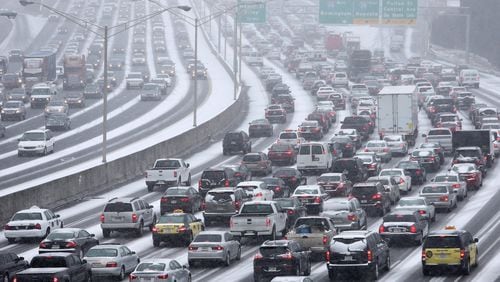As the metro area faces another dire winter forecast, it's hard to forget that only three years ago we let 2.6 inches of snow knock us on our collective backside, turning Atlanta into national laughingstock.
We called it "SnowJam '14." Not to be confused with "Snow Jam '82," where nearly the same thing happened, or "Snowpocalypse '11," which had been so recent that some leaders figured the region was statistically safe from another snow debacle for at least a decade.
The storm of January 2014 would be both painful and humiliating. Almost as deflating as the images of seas of stopped cars under a thin layer of snow was the Saturday Night Live skit where a cast member, with a Colonel Sanders goatee and a fake Southern drawl, described how he fled to the interstate and survived on "Dixie champagne" (Coke) until he was finally rescued by the sun.
SnowJam, though, wasn't just the handiwork of panicky Southerners. The Atlanta Journal-Constitution, in a post-storm analysis of the region's planning and response to the storm, called it "a series of cascading failures," one that went all the way to the top of the state's political leadership.
1) The region could have prepared for it, but didn’t
Local governments knew what can happen when Atlanta roads turn into skating rinks, and the AJC discovered leaders had both the funds and the opportunity to plan for a weather-induced traffic catastrophe like SnowJam.
At that point, metro Atlanta had received roughly $100 million from the U.S. Department of Homeland Security for anti-terrorism training and equipment, as well as for disaster training. And the Urban Area Security Initiative (UASI), composed of five counties and the city of Atlanta, was receiving $5 million a year.
If state emergency management officials had pressed for it, planning for a snowstorm could have fallen under UASI's purview, and our fractured region would have been far more prepared to coordinate between state, county and city governments. Other cities had used their UASI resources to plan for winter storms, the AJC found, most notably San Francisco, which has put those plans to use.
2) Forecasters called it, but our leaders didn’t want to be Chicken Littles
Weather forecasters were spot-on in predicting the scope and severity of the storm, just as they were in 2011. On that fateful Tuesday morning in 2014, at 3:38 a.m., the National Weather Service issued a winter storm warning, one rung below a blizzard warning. No one saw fit to wake up Gov. Nathan Deal and tell him.
Deal may have been more troubled by the prospect of overreacting — sounding the alarm for what turned out to be just another light dusting. Afterward, Deal said he should have urged people to stay home or to stagger drive times.
"Yes, I would have acted sooner and I think we learned from that and we will act sooner next time," Deal said. "But we don't want to be accused of crying wolf. Because if we'd been wrong, y'all would have been in here saying, 'Do you know how many millions of dollars you've cost the economy and the city of Atlanta?'"
3) Our top leader didn’t lead
Once awake, the governor didn’t exactly take charge. This was a big problem because, without a regional coordinated plan, he was the only one with both the legal and political muscle to make decisive judgment calls to cut through jurisdictional boundaries.
Instead, he went to a tourism event at the state Capital, unveiling a new “Gone With The Wind”-themed Georgia travel guide and posing for a photo with Rhett Butler and Scarlett O’Hara. Later he went to a Georgia Trend luncheon at the downtown Ritz-Carlton, where Atlanta Mayor Kasim Reed was being honored as Georgian of the Year. (Later that day, Reed and his staffers infuriated motorists by using emergency lanes to get to an interview at The Weather Channel.)
Deal didn’t activate the National Guard until nearly midnight, when school kids had been stranded on buses for more than eight hours.
4) We became the city too busy to communicate
When the snow started falling around lunch time, GEMA didn't use a system to send weather and traffic alerts directly to cell phones, despite receiving federal approval to use the technology in 2012. A spokesman said it hadn't been tested or configured yet.
With zero coordination between schools systems and the business community, metro highways, surface streets and side streets quickly became parking lots. Schools were dismissed and workers poured from offices at the same time.
The state’s multi-million dollar electronic sign system flashed useless messages at trapped drivers. The state’s mobile app gave wrong information about road clearing.
5) Police on the street didn’t take charge either
All over the region, police stood by as cars blocked intersections. Officers were too busy responding to wrecks and other emergencies to try to direct traffic. Although Cobb County and Sandy Springs police worked together to get traffic moving around the Johnson Ferry Road bridge, such cooperation was the exception, not the norm.
Traffic problems were worsened by the sheer number of agencies trying to solve them: 90 locally-elected governments in a 10-county metro area.
One police chief told the AJC he saw no point in communicating with other jurisdictions along the treacherous commute between Perimeter Mall and the Cobb County suburbs, because he knew I-75, I-285 and Ga. 400 were all completely gridlocked.
So drivers did all they could do: hunker down in the cold and wait. And wait. And wait.
SNL got one part right. When rescue came, it came from the sun.
About the Author







